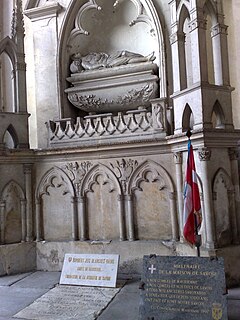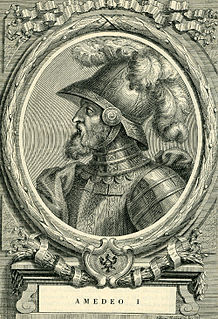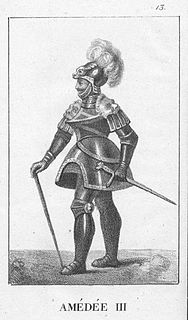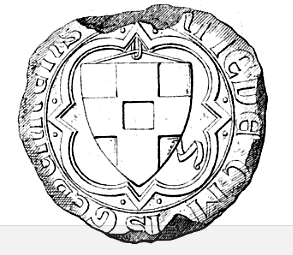Humbert of Savoy (c.1318–1374) was the eldest, but illegitimate son of Aymon, Count of Savoy, and half-brother of Amadeus VI. He first appears in documents in 1338 as sire of Ecluse and castellan of Tarentaise. He accompanied his father to Paris in 1339 and took part in the campaign against the English near Buironfosse, part of the Hundred Years' War.
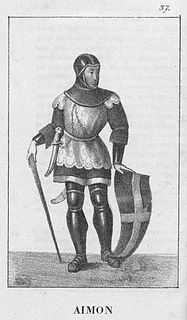
Aymon, nicknamed the Peaceful, was Count of Savoy from 1329 to 1343.

Amadeus VI, nicknamed the Green Count was Count of Savoy from 1343 to 1383. He was the eldest son of Aymon, Count of Savoy and Yolande Palaeologo of Montferrat. Though he started under a regency, he showed himself to be a forceful leader, continuing Savoy's emergence as a power in Europe politically and militarily. He participated in a crusade against the Turks who were moving into Europe.
A castellan is the title used in Medieval Europe for an appointed official, a governor of a castle and its surrounding territory referred to as the castellany. The title of governor is retained in the English Prison system, as a remnant of the medieval idea of the castellan as head of the local prison. The word stems from the Latin Castellanus, derived from castellum "castle". Sometimes also known as a constable of the castle district, the Constable of the Tower of London is, in fact, a form of castellan, with representative powers in the local or national assembly. A castellan was almost always male, but could occasionally be female, as when, in 1194, Beatrice inherited her father's castellany of Bourbourg upon the death of her brother, Roger.
In 1341 Humber married Andrée (Andrea), heiress of Arvillars, near Montmélian, and established a local dynasty there: his eldest son, Humbert II, inherited Arvillars, and his second, Amadeus, held the lordship of Mollettes. Humbert's second wife was Marguerite de Chevron-Villette. Under Amadeus VI he was castellan of Chillon, then Maurienne, Châtelard-en-Bauges and again of Tarentaise. In 1357 he was made bailli of the County of Savoy and castellan of Montmélian, and held both until his death.

Montmélian is a commune in the Savoie department in the Auvergne-Rhône-Alpes region in south-eastern France.

Maurienne is one of the provinces of Savoy, corresponding to the arrondissement of Saint-Jean-de-Maurienne in France. It is also the original name of the capital of the province, now Saint-Jean-de-Maurienne.

The County of Savoy was a State of the Holy Roman Empire which emerged, along with the free communes of Switzerland, from the collapse of the Burgundian Kingdom in the 11th century. It was the cradle of the future Savoyard state.
